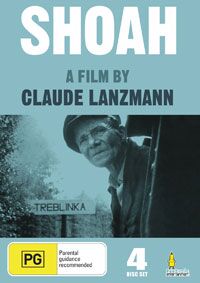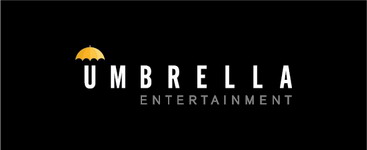Shoah (1985) |
|
Shoah (1985) |
|


|
| BUY IT |
| General | Extras | ||
| Category | Documentary | None | |
| Rating |

|
||
| Year Of Production | 1985 | ||
| Running Time | 541:40 (Case: 540) | ||
| RSDL / Flipper |
Dual Layered Multi Disc Set (4) |
Cast & Crew | |
| Start Up | Menu | ||
| Region Coding | 1,2,3,4,5,6 | Directed By | Claude Lanzmann |
|
Studio
Distributor |
 Umbrella Entertainment |
Starring |
Simon Srebnik Michael Podchlebnik Motke Zaidl Hanna Zaidl Jan Piwonski Itzhak Dugin Richard Glazer Paula Biren Pana Pietyra Pan Filipowicz Pan Falborski Abraham Bomba Czeslaw Borowi |
| Case | 4-Way Cross-Dual | ||
| RPI | $49.95 | Music | None Given |
| Video | Audio | ||
| Pan & Scan/Full Frame | Full Frame | French Dolby Digital 2.0 mono (192Kb/s) | |
| Widescreen Aspect Ratio | 1.29:1 | ||
| 16x9 Enhancement | No | ||
| Video Format | 576i (PAL) | ||
| Original Aspect Ratio | 1.37:1 | Miscellaneous | |
| Jacket Pictures | No | ||
| Subtitles |
English English for the Hearing Impaired |
Smoking | Yes |
| Annoying Product Placement | No | ||
| Action In or After Credits | No | ||
"They screamed. They knew what was happening. At first the Jews thought they were going to be deloused. But they soon understood. Their screams grew wilder and wilder. Horrifying screams. Screams of terror. Because they knew what was happening to them." Martha Michelsohn.
In 1944-45 Allied forces swept across Europe with great momentum, capturing German strong-holds and eventually crushing the ruling Nazi dictatorship. While this objective was paramount, Allied forces were completely unaware of the untold horrors that awaited them in the scores of concentration camps scattered across the Nazi occupied territories. By the time of liberation, approximately six million Jewish men, women and children had been murdered in these death camps by the systematic genocide, known as the Final Solution.
The first major concentration camp was liberated by Soviet troops in July 1944. However, it would take about a year for all the concentration camps to be liberated by either Soviet, American or British forces.
The initial reaction to the horrors faced by the liberators was that these camps should be completely destroyed. In some camps, the Nazi's had even tried to cover their atrocities by demolishing the buildings themselves. The camps of Belzec, Sobibor and Treblinka were partly destroyed by the Germans in 1943, long before Allied forces could reach their perimeters. The decision was made by the Allied hierarchy that the camps should be left in tact, to stand as a stark reminder to the world of these atrocities. Today, many of these camps have become museums, providing education to future generations about the horrors of the holocaust. The many feature films and documentaries made about the holocaust also serve as an important lesson to new generations. Camp survivors have a painful, yet vital duty to tell the world of their experiences and filmmakers have provided the means of capturing their stories on permanent record.
Over the years, many great films have documented the horrors encountered by the Jewish people at the hands of the Nazi regime. From the brutal reality of Alain Resnais' Night And Fog, to the more dramatic adaptations such as Steven Spielberg's, Schindler's List. But undoubtedly, one of the greatest film records regarding the holocaust is the nine hour epic documentary, Shoah.
Shoah is the product of eleven years of intensive work by French filmmaker, Claude Lanzmann. He travelled to many countries filming the memoirs of a wide cross section of people, all with some connection to the holocaust. These people are not just camp survivors, but anyone with memories of the camps and the atrocities perpetrated inside them.
Claude Lanzmann is forthright in his interviewing manner. He searches for definitive answers to questions, but allows his subjects the liberty to covey their stories at a convenient pace. Often he will ask a question in a manner that encourages a more detailed response. Even relatively small elements of detail are very important to Lanzmann and they contribute greatly to the complete perspective.
No time is spent easing the audience into the film. Shoah opens with the incredible story of Simon Srebnik, a survivor of the Chelmno camp in Poland. Simon was only one of two Jewish survivors from the 400,000 in the camp (the other survivor, Michaël Podchlebnik is also interviewed in the film). The stories of both these men are quite moving.
Every testimony that follows carries enormous weight, but another worth singling out is Lanzmann's chilling interview with SS guard, Franz Suchomel. Suchomel claims that he was originally told that the camp he was being sent to (Treblinka) was a work camp and his duty would be simply guarding Jewish prisoners. This claim was favourably upheld at a subsequent war crimes trial. Naturally, Suchomel was not keen on being filmed or even named in the film. So depending on your moral stand point, the method for obtaining Mr Suchomel's testimony may be questionable. For this interview, Lanzmann covertly used a hidden camera and recorded the interview against Suchomel's wishes. The image quality may be poor and Lanzmann's methods questionable, but the testimony is a vital piece in this comprehensive record.
Shoah is raw and rather loose in structure. Claude Lanzmann adopted a guerrilla style of filmmaking, which meant that he could move with minimal crew and work on a small budget. The camera is often hand-held, with far more attention paid to obtaining the information, than the technical values. This results in a gritty, no-nonsense documentary that is vastly more informative than it is aesthetic. Lanzmann also resisted convention by not using a single second of archival footage in his presentation. Shoah relies mostly on the testimonies of the people. All of this is underpinned by haunting vision of locations, as they stand today (circa 1985). The camera moves slowly along rail tracks leading to the entrance of Auschwitz. We move through the remains of gas chambers and crematoriums. We linger over now beautiful vistas that were once places of trepidation. Lanzmann's camera is patient and deliberate, providing images that will stay with you.
Shoah is not a documentary series, it is a nine hour film (approx 9.5 hour cinema running time), which is presented here in a four DVD set. The only official break in the film occurs between the first and second era, which is at the completion of disc two. At the end of disc's one and three, the film simply stops and you're prompted to insert the next disc. Each DVD has an excellent scene selection menu, which makes finding a particular interview really quite simple.
Shoah is more than a documentary - it's a historical document that is as compelling as you are ever likely to see. Despite all the sorrow, this is a film that everyone should see at least once in their lifetime.
Disc One: The First Era Part 1 57 Chapters (146:50)
Disc Two: The First Era Part 2 29 Chapters (114:30)
Disc Three: The Second Era Part 1 16 Chapters (140:00)
Disc Four: The Second Era Part 2 21 Chapters (140:20 )
To pass critical comment on the image quality of Shoah seems really superficial. The film was made without high technical values and although the image quality is perfectly acceptable, the limitations are obvious. This rawness is a part of what makes Shaoh the experience that it is.
Shoah is presented full frame in an aspect ratio of 1.29:1, which is not 16x9 enhanced. The Internet Movie Database lists the correct aspect ratio as 1.37:1.
While it's not at all problematic, the quality of the image is quite soft. This is not a result of the transfer, but rather an accurate presentation of the source material. If anything, the presence of film grain actually enhances the authenticity and emotion of the film. Blacks were generally clean, with minimal noise. Shadow detail was moderate and still quite acceptable.
Colours are very passive, which accurately reflects the winter season, many of the locations and the sombre mood of Shoah. They appear well balanced throughout the film.
There were no MPEG artefacts evident in the transfer. Film-to-video artefacts, including the odd instance of telecine wobble was noticed, but there was nothing of great consequence. Minor film artefacts were occasionally evident.
English subtitles and English subtitles for the hearing impaired are available. Both are easily legible in bold white.
All four DVD's are dual layer DVD 9 discs. The layer change on each DVD was easily noticed, but not particularly disruptive. The layer change on disc one occurs at 76:45. The layer change on disc two occurs at 58:35. The layer change on disc three occurs at 71:50 and the layer change on disc four occurs at 69:04.
| Sharpness | |
| Shadow Detail | |
| Colour | |
| Grain/Pixelization | |
| Film-To-Video Artefacts | |
| Film Artefacts | |
| Overall |
As previously mentioned, Shoah was made without high technical standards. As such, the audio is also basic, but still perfectly acceptable.
There is only one audio track on the DVD, French Dolby Digital 2.0 mono (192Kb/s). Many different languages are spoken during Shoah including French, Hebrew, Yiddish, German, Polish and English.
Dialogue quality appeared to be excellent throughout. The occasional English conversation was certainly clear and easily understood.
On the first disc there were a few instances where a very slight lapse in audio sync was evident. This wasn't overly distracting.
There is no music score used in Shoah.
Naturally, the surround channels and subwoofer were not used.
| Dialogue | |
| Audio Sync | |
| Clicks/Pops/Dropouts | |
| Surround Channel Use | |
| Subwoofer | |
| Overall |
The main menu features some very subtle animation, is 16x9 enhanced and has no audio.
There are no extras.
NOTE: To view non-R4 releases, your equipment needs to be multi-zone compatible and usually also NTSC compatible.
There is not a great difference between this Umbrella release of Shoah and the R1edition released by New Yorker Films.Both are four disc sets. The R1 version has the addition of French subtitles and a biography of Claude Lanzmann.
Note: There is a region free, Masters Of Cinema edition that was released in the UK in February 2007. This edition has the addition of a 184-page book featuring a masterclass with Claude Lanzmann and an essay about the film by Stuart Liebman. It appears that the local Umbrella release is identical to this UK release - unfortunately though, without the book. The Umbrella release is also under the Masters of Cinema banner and all menus appear to be completely identical.
Shoah is an intense, but deeply rewarding experience that everyone should see at least once in their lifetime. Once you have seen this film, you are unlikely to ever forget it.
The video and audio transfers are faithful to the source material.
There are no extras. This is a rare instance when extras really are not a requirement - the film has said it all.
| Video | |
| Audio | |
| Extras | |
| Plot | |
| Overall |
| Review Equipment | |
| DVD | JVC XV-N412, using Component output |
| Display | Hitachi 106cm Plasma Display 42PD5000MA (1024x1024). Calibrated with THX Optimizer. This display device is 16x9 capable. This display device has a maximum native resolution of 1080i. |
| Audio Decoder | Built in to amplifier/receiver. Calibrated with THX Optimizer. |
| Amplification | Panasonic SA-HE70 80W Dolby Digital and DTS |
| Speakers | Fronts: Jensen SPX7 Rears: Jensen SPX4 Centre: Jensen SPX13 Subwoofer: Jensen SPX17 |